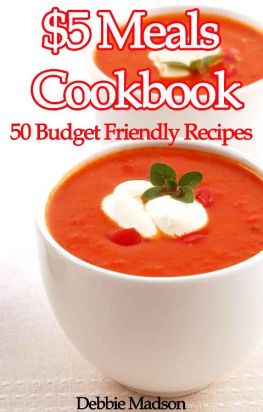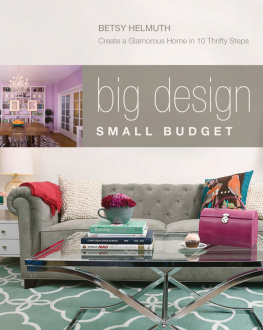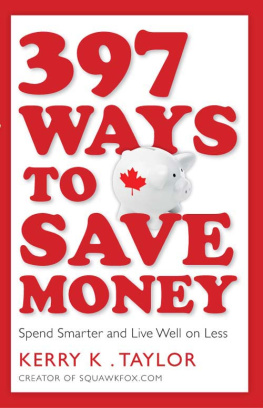Introduction
Our society believes that love and worth are measured by things. Its time we recognize and reject this lie.
Because youre worth it.
We are worth it because we have inherent value as individuals, not because of the toiletries we use. Cars cannot determine our significance. Shoes cannot make us better people.
When you care enough to send the very best.
Were pressured to believe that the amount of money spent on a gift is directly correlated with how much the recipient is loved. Were told that the kind of peanut butter we choose will establish if were caring or not. Were convinced that paying more for a logo will somehow make us more remarkable.
Reassuringly expensive.
This mind-set must be recognized and altered in order to be liberated from buying to fill a void, establish status, assure value, or provide a reward.
Once free, we will be able to buy thrift store clothes without believing we are diminished by doing so. We will be free to purchase an older car knowing we are not defined by a vehicle. No matter our shampoo brand, we will understand that we are valuable and we love our family no less because of product choice.
We work hard so you dont have to.
Weve been sold on convenience. We pay to have people walk the dog, raise our kids, plan and make our meals. We must choose between conveniences and savings. When we choose to do the work ourselves, the savings will really add up.
Become a part of the process. Involve your family and friends as you save money. Allow relationship to grow as you explore the new lifestyle. Consume to live instead of live to consume. Use these 99 ways to learn how to save thousands while living a freer and more fully balanced life!
We are worth it because we are created in the image of God and have inherent value as individuals, not because of the toiletries we use. Cars cannot determine our significance. Shoes cannot make us better people.
As you use 99 Ways to Stretch Your Home Budget, please keep in mind that the estimated savings included with each way is based on a family of four using commodities and services in various areas of the United States. You may find your savings differ from the amounts proposed because of where you live and your individual tastes and practices.
Give us today our daily bread.
M ATTHEW 6:11
To stretch your food budget the most, youll need two things: a pantry and a freezer.
A pantry doesnt have to be a built-in, dedicated food closet. Mines a utility shelf in the garage and under-the-bed storage boxes. Wherever you can find extra space to store dry goods, claim it for food storage.
If you dont have a freezer, prioritize your existing freezer space. If you know someone who would share a portion of her deep freezer with you, pursue that option.
As you shop for specials and stock up when items are on sale, youll need places to store your food. As you extend time between shopping visits, youll use your freezer and pantry to shop and put together a meal.

P LAN M ENUS
The first step to reduce your food bill is planning. Plan a menu for at least a week at a time, two if you can. (Fewer trips to the store mean savings!) A menu will direct what you buy and eliminate unnecessary purchases.
Create a menu that overlaps from one meal to the next. For example, brown ground beef and season it with Mexican seasoning (see number 12 for more about seasonings). Then divide the meat and use half for Mondays chimichangas and the other half for Thursdays tacos. The lettuce and tomatoes from Tuesdays salad make toppings for Thursdays tacos. Friday can be soup day, using leftovers from the week.
When you go to shop, leave the kids at home or with a friend. And eat before you go. It will be easier to pass on the markdown doughnuts.
(Savings = $15 per week, $780 per year)

K NOW THE R IGHT P RICE
Plan your menu around store circulars. Use coupons only on items youre going to buy anyway. Shop at stores that double the coupon value. Take a calculator. Divide the price by quantity to compare. Store brands arent always cheaper.
Watch for mistakes at the checkout. Some stores give you an item free if they goof.
Learn to identify a good deal. Keep a price booka record of what items cost and where to find the best price. If one sale boasts a price you can beat with a regular price elsewhere, you wont be suckered in. Before you know it, youll be set to appear on The Price Is Right!
Watch out for 5 for $5 schemes. If you need only one, dont buy five. For buy one get one, ask to have one for half price rather than buy an extra item you dont need.
(Savings = $15 per week, $780 per year)

P ACK THE P ANTRY
In addition to your weekly menu items, stock up on staples with markdowns, loss leaders, and clearance items. Check store clearance racks.
Buy large meat packs that reduce price for higher quantity. Divide and freeze. If canned or dry goods are exceptionally reduced, buy up to stock your pantry. If theres a great bargain on produce, plan a canning or freezing day. Only buy what you can handle. Dont let a good deal sway you. Someone I know buys because of the amount of saving, not because she needs the item. That often leads to waste.
Another time to stock up is during seasonal harvests or specials. Farmers markets can be a good source of produce for canning or freezing.
Use outlet grocery stores with caution. Compare prices and dont buy more than you can store or use. Buy larger quantities only if the price per unit is better.
(Savings = varies)

M EAT OF THE M ATTER
Meat is the most expensive regular ingredient in the American diet. And we usually eat more than the body needs. Reduce the amount of meat you buy and serve, and significant savings will add up!
Some people want meatand plenty of itevery day. They will be harder to wean and satisfy with alternatives. Use recipes that stretch meat, like sloppy joes instead of hamburgers and pulled barbecue pork or beef instead of a roast. Meat loaf is good for using fillers like oatmeal, breadcrumbs, or rice. Soups are great for stretching meat. Try quiche, pot pies, and stir fry. Mix in beans to make meat go further and add protein.
























 P LAN M ENUS
P LAN M ENUS K NOW THE R IGHT P RICE
K NOW THE R IGHT P RICE P ACK THE P ANTRY
P ACK THE P ANTRY M EAT OF THE M ATTER
M EAT OF THE M ATTER